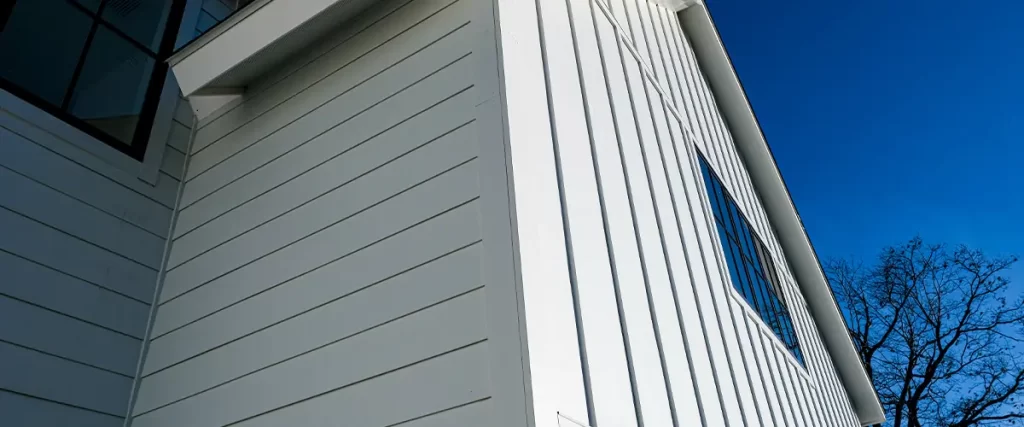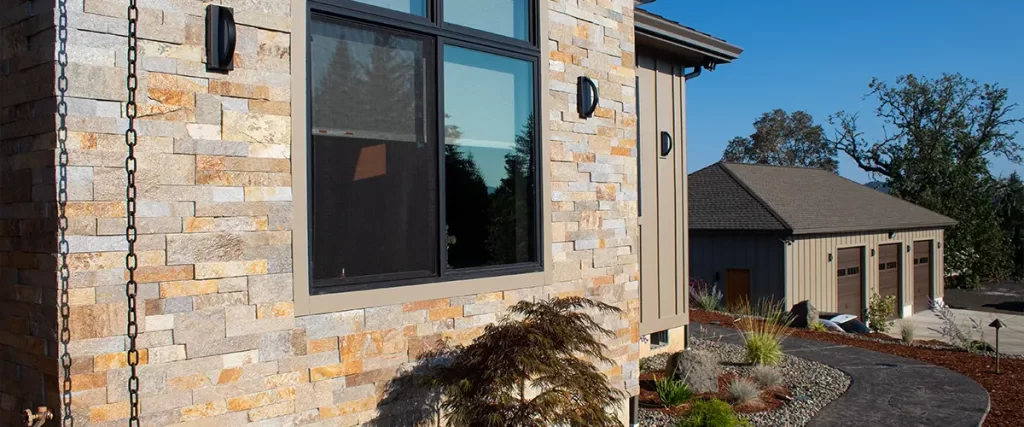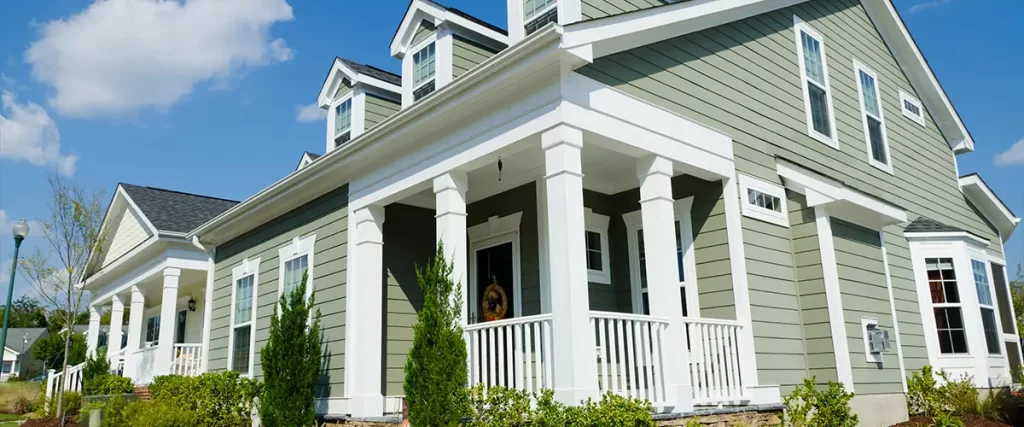Choosing the right siding materials can be hard for homeowners. One fact is, vinyl siding and fiber cement siding are popular choices. Our article will guide you through different materials, their pros and cons, and how to pick the best one for your home.
Read on for helpful insights.
Types of Siding Materials
There are various types of siding materials available for homeowners. These include vinyl, wood, fiber cement, metal, and stone veneer siding. Each material has unique characteristics and benefits that cater to different preferences and needs.

Vinyl Siding
Vinyl siding is a popular choice for homeowners. It’s known for being low maintenance and durable. This type of siding can withstand elements like rain and wind. Vinyl also comes in many colors and styles to match your house.
Vinyl siding offers great value, combining durability with easy upkeep.
It doesn’t need paint or stain, which saves time and money. Plus, vinyl siding installation is usually less costly than other materials. Its appeal lies in the balance between cost-effectiveness and visual variety.

Wood Siding
Wood siding gives homes a classic and natural look. It comes in many styles, including planks, panels, and shingles. Homeowners often choose wood for its natural beauty which adds to a home’s curb appeal.
Wood can be painted or stained to match any home’s style.
However, wood requires more upkeep than other siding materials like vinyl or fiber cement. It needs regular painting or staining to protect against weather and insects. Some types of wood are better at resisting moisture and termites than others.
For example, cedar is known for its durability against rot and insects. Despite the maintenance needed, many prefer wood siding for its timeless appearance and ability to enhance the exterior of their homes.

Fiber Cement Siding
Fiber cement siding is a mix of cement, sand, and cellulose fibers. It’s known for being fire resistant and offers great protection from termites and rot. Many homeowners choose it because it can look like wood, brick, or stucco but lasts much longer.
Fiber cement siding cost varies but averages about $5 to $10 per square foot installed. This makes it a good choice for those wanting the look of natural materials without high maintenance.
Companies like James Hardie lead in fiber cement products, offering a wide range of styles and colors. These options help match any home design. Despite its benefits, installing this siding needs skilled professionals due to its weight and composition.
Metal Siding
Metal siding is a popular choice for homeowners due to its durability and low maintenance. It’s highly resistant to impact, fire, and pests. With modern designs and textures available, metal siding can enhance the exterior look of homes.
Steel siding, in particular, is known for its longevity and minimal need for repairs.
Steel siding has become a favorite among homeowners looking for long-lasting protection for their home’s exterior walls. With advancements in technology, steel sidings now boast impressive insulation properties alongside their durability.

Stone Veneer Siding
Stone veneer siding is a popular choice for homeowners looking to add a natural and elegant look to their homes. It is made from thin, real stone that is lighter and more affordable than traditional masonry.
The exterior stone veneer provides durability and impact resistance, making it suitable for various exterior applications, including siding styles and trim. Its high-quality appearance brings about an enhanced curb appeal, elevating the overall aesthetic of any house.
For those desiring durable materials with a sophisticated finish for their home’s exterior, stone veneer siding offers an appealing option. This type of siding also comes in different colors and textures, offering homeowners access to customized designs best suited to their desires for enhancing their property’s allure.
With its long-lasting nature and authentic appearance akin to natural stone, it proves to be among the finest choices available in the world of house siding options.
Pros and Cons of Popular Siding Materials
Evaluating the advantages and disadvantages of popular siding materials is crucial for homeowners. Here’s a concise overview encapsulated in a table format:
| Siding Material | Pros | Cons |
| Vinyl Siding | Low maintenance, cost-effective, and durable. Wide range of colors and styles available. | Can crack or fade over time. May melt near extreme heat sources. |
| Wood Siding | Natural beauty and timeless appeal. Can be painted or stained. Good insulator. | Requires regular maintenance. Susceptible to insects and rot. |
| Fiber Cement Siding | Fire resistant, termite-proof, and durable. Mimics wood but requires less upkeep. | Installation is complex. Higher initial cost than some other options. |
| Metal Siding | Fireproof, eco-friendly, and requires minimal maintenance. Lasts long. | Can dent and is prone to rust if not properly protected. Conducts heat. |
| Stone Veneer Siding | Offers a natural look. Durable and fire-resistant. Boosts home value. | High installation and material costs. Requires skilled installer. |
This table aims to provide homeowners with straightforward insights into selecting the right siding material for their homes.
How to Choose the Right Siding Material
When selecting siding material for your home, keep these important factors in mind:
- The climate in your area: Choose durable materials that can withstand the weather patterns in your region. For example, vinyl siding is low-maintenance and suitable for various climates.
- Budget considerations: Different siding materials come with varying costs. Vinyl and metal sidings are often more budget-friendly options compared to natural wood or stone veneer.
- Maintenance requirements: Consider the upkeep each material demands. For instance, wood siding may need regular painting and sealing, while fiber cement is known for its low maintenance.
- Aesthetic appeal: Select a siding material that complements the overall look of your home. Vinyl siding offers a wide range of colors and textures, while natural wood provides a classic and timeless appearance.
- Energy efficiency: Certain sidings offer insulation properties, which can impact your home’s energy consumption. Engineered wood and fiber cement are known for their energy-efficient qualities.
Top Siding Manufacturers to Consider
When choosing siding materials, selecting a reputable manufacturer ensures quality, durability, and a variety of design options.
- James Hardie : Known for their industry-leading fiber cement siding, James Hardie provides durable, low-maintenance, and aesthetically pleasing options for homeowners.
- CertainTeed : CertainTeed offers a wide selection of vinyl and fiber cement siding known for their quality and energy-efficient solutions.
- LP SmartSide : LP SmartSide specializes in engineered wood siding, delivering strength, flexibility, and visually appealing wood textures for modern homes.
- Alside : Alside produces versatile vinyl siding with exceptional energy efficiency, available in various colors and styles to match any aesthetic.
Frequently Asked Questions About Siding Materials
1. What is the most durable siding material?
Fiber cement and engineered wood are considered among the most durable siding materials. For example, James Hardie’s fiber cement siding is resistant to weather, fire, and pests, while LP SmartSide’s engineered wood offers strength and flexibility to withstand impact and harsh conditions.
2. Which siding material is the most energy-efficient?
Vinyl siding from manufacturers like CertainTeed and Alside is highly energy-efficient, especially when insulated options are selected. These materials help reduce heat transfer, keeping homes cooler in the summer and warmer in the winter.
3. What siding is best for low maintenance?
Vinyl siding, such as those offered by Alside and Ply Gem, is a top choice for homeowners seeking low-maintenance solutions. It resists fading, peeling, and rot, requiring only occasional cleaning with a garden hose to maintain its appearance.
4. How do I choose the best siding color and style for my home?
Manufacturers like James Hardie and Ply Gem provide a wide variety of colors and styles, allowing you to customize the look of your home. Consider your home’s architectural style, neighborhood trends, and personal preference when making your selection. Many manufacturers also offer online visualization tools to help you preview options.
5. Is fiber cement siding worth the investment?
Yes, fiber cement siding, like that offered by James Hardie, is an excellent long-term investment due to its durability, fire resistance, and aesthetic appeal. While it may have a higher upfront cost than some materials, its longevity and low maintenance requirements often make it worth the expense over time.

Trust Our Experienced Team
Our team has been delivering exceptional siding services for years, ensuring professionalism and top-tier results. Work with industry experts to save money long-term—contact us at (402) 651-1493 to start your project!
